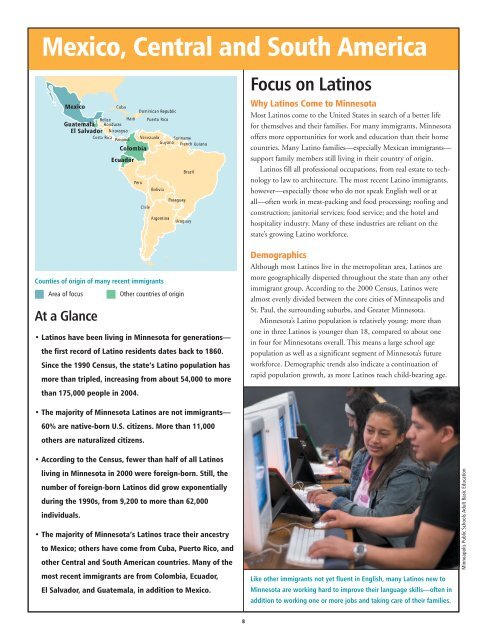Immigration in Minnesota - The Minneapolis Foundation
Immigration in Minnesota - The Minneapolis Foundation
Immigration in Minnesota - The Minneapolis Foundation
Create successful ePaper yourself
Turn your PDF publications into a flip-book with our unique Google optimized e-Paper software.
Mexico, Central and South America<br />
Counties of orig<strong>in</strong> of many recent immigrants<br />
At a Glance<br />
• Lat<strong>in</strong>os have been liv<strong>in</strong>g <strong>in</strong> M<strong>in</strong>nesota for generations—<br />
the first record of Lat<strong>in</strong>o residents dates back to 1860.<br />
S<strong>in</strong>ce the 1990 Census, the state’s Lat<strong>in</strong>o population has<br />
more than tripled, <strong>in</strong>creas<strong>in</strong>g from about 54,000 to more<br />
than 175,000 people <strong>in</strong> 2004.<br />
• <strong>The</strong> majority of M<strong>in</strong>nesota Lat<strong>in</strong>os are not immigrants—<br />
60% are native-born U.S. citizens. More than 11,000<br />
others are naturalized citizens.<br />
• Accord<strong>in</strong>g to the Census, fewer than half of all Lat<strong>in</strong>os<br />
liv<strong>in</strong>g <strong>in</strong> M<strong>in</strong>nesota <strong>in</strong> 2000 were foreign-born. Still, the<br />
number of foreign-born Lat<strong>in</strong>os did grow exponentially<br />
dur<strong>in</strong>g the 1990s, from 9,200 to more than 62,000<br />
<strong>in</strong>dividuals.<br />
• <strong>The</strong> majority of M<strong>in</strong>nesota’s Lat<strong>in</strong>os trace their ancestry<br />
to Mexico; others have come from Cuba, Puerto Rico, and<br />
other Central and South American countries. Many of the<br />
most recent immigrants are from Colombia, Ecuador,<br />
El Salvador, and Guatemala, <strong>in</strong> addition to Mexico.<br />
8<br />
Focus on Lat<strong>in</strong>os<br />
Why Lat<strong>in</strong>os Come to M<strong>in</strong>nesota<br />
Most Lat<strong>in</strong>os come to the United States <strong>in</strong> search of a better life<br />
for themselves and their families. For many immigrants, M<strong>in</strong>nesota<br />
offers more opportunities for work and education than their home<br />
countries. Many Lat<strong>in</strong>o families—especially Mexican immigrants—<br />
support family members still liv<strong>in</strong>g <strong>in</strong> their country of orig<strong>in</strong>.<br />
Lat<strong>in</strong>os fill all professional occupations, from real estate to technology<br />
to law to architecture. <strong>The</strong> most recent Lat<strong>in</strong>o immigrants,<br />
however—especially those who do not speak English well or at<br />
all—often work <strong>in</strong> meat-pack<strong>in</strong>g and food process<strong>in</strong>g; roof<strong>in</strong>g and<br />
construction; janitorial services; food service; and the hotel and<br />
hospitality <strong>in</strong>dustry. Many of these <strong>in</strong>dustries are reliant on the<br />
state’s grow<strong>in</strong>g Lat<strong>in</strong>o workforce.<br />
Demographics<br />
Although most Lat<strong>in</strong>os live <strong>in</strong> the metropolitan area, Lat<strong>in</strong>os are<br />
more geographically dispersed throughout the state than any other<br />
immigrant group. Accord<strong>in</strong>g to the 2000 Census, Lat<strong>in</strong>os were<br />
almost evenly divided between the core cities of M<strong>in</strong>neapolis and<br />
St. Paul, the surround<strong>in</strong>g suburbs, and Greater M<strong>in</strong>nesota.<br />
M<strong>in</strong>nesota’s Lat<strong>in</strong>o population is relatively young: more than<br />
one <strong>in</strong> three Lat<strong>in</strong>os is younger than 18, compared to about one<br />
<strong>in</strong> four for M<strong>in</strong>nesotans overall. This means a large school age<br />
population as well as a significant segment of M<strong>in</strong>nesota’s future<br />
workforce. Demographic trends also <strong>in</strong>dicate a cont<strong>in</strong>uation of<br />
rapid population growth, as more Lat<strong>in</strong>os reach child-bear<strong>in</strong>g age.<br />
Like other immigrants not yet fluent <strong>in</strong> English, many Lat<strong>in</strong>os new to<br />
M<strong>in</strong>nesota are work<strong>in</strong>g hard to improve their language skills—often <strong>in</strong><br />
addition to work<strong>in</strong>g one or more jobs and tak<strong>in</strong>g care of their families.<br />
M<strong>in</strong>neapolis Public Schools Adult Basic Education


